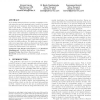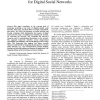SP
2010
IEEE
14 years 3 months ago
2010
IEEE
—Social networking sites such as Facebook, LinkedIn, and Xing have been reporting exponential growth rates. These sites have millions of registered users, and they are interestin...
KDD
2010
ACM
14 years 3 months ago
2010
ACM
In the traditional link prediction problem, a snapshot of a social network is used as a starting point to predict, by means of graph-theoretic measures, the links that are likely ...
KDD
2010
ACM
14 years 3 months ago
2010
ACM
Compressing social networks can substantially facilitate mining and advanced analysis of large social networks. Preferably, social networks should be compressed in a way that they...
CSE
2009
IEEE
14 years 3 months ago
2009
IEEE
This paper contributes to the evolving body of knowledge pertaining to the study of digitally-enabled social networks, their usage, and their effects on people, organization, and s...
DIM
2007
ACM
14 years 3 months ago
2007
ACM
Online social networks are formed when web applications allow users to contribute to an online community. The explosive growth of these social networks taxes the management capaci...
INCDM
2010
Springer
14 years 3 months ago
2010
Springer
This paper reports on a mechanism to identify temporal spatial trends in social networks. The trends of interest are defined in terms of the occurrence frequency of time stamped p...
ASUNAM
2009
IEEE
14 years 3 months ago
2009
IEEE
In this paper, we present a horizontal view of social influence, more specifically a quantitative study of the influence of neighbours on the probability of a particular node to jo...
ASUNAM
2009
IEEE
14 years 3 months ago
2009
IEEE
Previous research in Kyrgyzstan has demonstrated the importance of close social networks as avenues for gathering and sharing information, assistance and goods in the country. How...
EDBT
2010
ACM
14 years 3 months ago
2010
ACM
With more and more social network data being released, protecting the sensitive information within social networks from leakage has become an important concern of publishers. Adve...
DIGITALCITIES
2001
Springer
14 years 4 months ago
2001
Springer
Much thinking about digital cities is in terms of community groups. Yet, the world is composed of social networks and not of groups. This paper traces how communities have changed ...



